
Ultimate Beginners Guide for Learning How to Play Guitar Chords
When first learning the guitar, one of the most important things to learn is the guitar chords. There are many different types of chords; some are easy to play while others are more difficult.
What is a chord? A chord is a group of at least 3 notes played simultaneously. Those notes can also be played as an arpeggio, where you play the notes separately. This is also called a “Broken Chord”.
Each note has an important role. The most common chords are Triads, meaning they have only 3 notes which are separated by an interval of thirds. The triad is composed of a Root, Third, and Fifth (first, third, and fifth notes of the major scale).
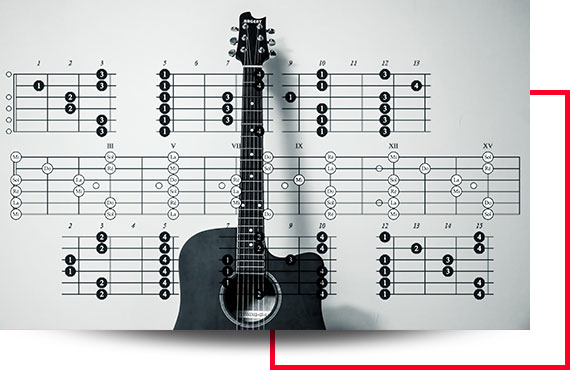
There are different types of chords, the main ones are Major, Minor, and Dominant.
Majors are built by a root, major third, and a perfect fifth.
Minors are built by a root, minor third, and a perfect fifth.
Dominant is a bit more advanced since it has 4 notes (basic dominant chord), consisting of a root, major third, perfect fifth, plus a minor 7th.
Easy Way to Learn Guitar Chords: Techniques
Knowing these 3 types of chords you can play thousands of songs. Actually, after learning how to play guitar chords with just majors and minors you could then learn how to play guitar songs of any kind.
There are 2 main techniques or ways to play these chords. Open chords and Barre chords. For all of you who are beginners trying to learn how to play basic guitar chords, the first step would be “Open chords”.
Open chords are those that are played in their first position (first frets) and includes 1 or more open strings. Unfortunately, there’s no way to play open chords in every tonality, which is why we need to know how to play barre chords as well.
Here´s a list of some of the most commonly used open chords:



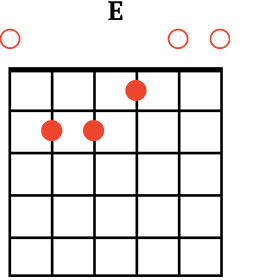

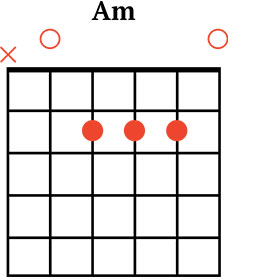




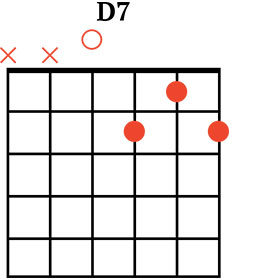

Open Major Chords: A, C, D, E, G





Open Minor Chords: Am Dm Em



Open Dominant Chords: A7, C7, D7, E7, G7, B7







Chromatic scale (ascending): C C# D D# E F F# G G# A A# B
Chromatic scale (descending): C B Bb A Ab G Gb F E Eb D Db
So keep in mind that those are notes, not chords. As we said, chords are made of stacks of thirds. So what is a third? A third is a musical interval that is placed at 2 tones (4 semitones) or 1 tone and a half (3 semitones) from any given note, depending on if it’s major or minor. Let’s look at some examples:
If the root is C, the major third would be E and a minor third would be Eb.
If the root is A, the major third would be C# and a minor third would be C.
The other note for the chord is the perfect fifth. To make it simple, it is the fifth note from the root or any note in a diatonic scale. So the fifth from C is G, from A is E, from G, is D, etc.
A perfect fifth is the 5th note from the root in a diatonic scale context. For example, G in the perfect fifth of C. If we use the chromatic scale to count we could say that it´s at 7 semitones
(C: C# D D# E F F# G).
Another interval that we need to know 7th. For now, let´s take a look at the minor 7th interval, which is the one that dominant chords have. Later we will see it deeper…
So the 7th minor interval is at 10 semitones above any given note, in our case (dominant Chord) 10 semitones above the root. So for example, from A would be G.
(A: A# B C C# D D# E F F# G)
So now we have enough information to know what notes are in a basic chord.

Let´s list some examples:
C major (C) – root: C, major third: E, perfect fifth: G
A minor (Am) – root: A, major third: C, perfect fifth: E
G major (G) – root: G, major third: B, perfect fifth: D
C dominant (C7) – root: C, major third: E, perfect fifth: G Minor 7th: Bb

In the case of C7 and the minor 7th interval, we need to know something called Enharmonic. When we talked about the chromatic scale we wrote it in 2 different ways, ascending and descending. Of course, both have the same notes but they are written differently. When ascending we use # and when descending we use b for the semitones. So have that in mind, we need to know that both notes with # and b are the same in our instruments but when we wrote them on paper we need to do it properly.
So that’s what Enharmonic notes are and look at some examples to know what we are talking about.
So let’s look at why the minor 7th of C is Bb and not A#. Actually, if we play that note on a guitar or any instrument it will be the same note. Both are at a distance of 10 semitones. Let´s count it first with # (sharps) and then with b (flats).
C C# D D# E F F# G G# A A#
1 2 3 4 5 6 7 8 9 10
C Db D Eb E F Fb G Ab A Bb
1 2 3 4 5 6 7 8 9 10

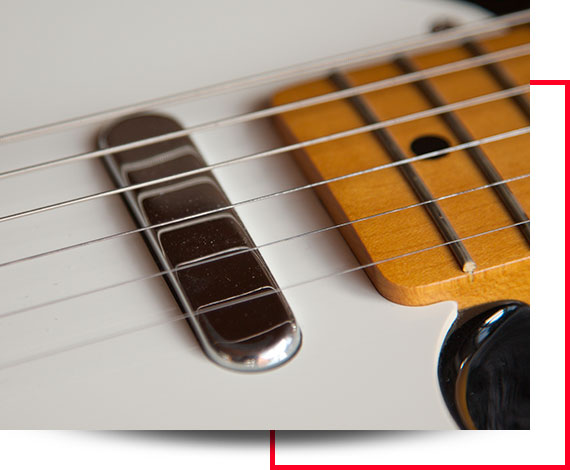
As you can see both notes are at the same distance. But before seeing if the note is sharp or flat, we have to target the 7th note. So we don’t need to count the intervals at first, just find the 7th note from the diatonic scale, in this case from C.
C D E F G A B
1 2 3 4 5 6 7
So, once we know that B is the 7th note from the root (C), the 2nd step is counting the semitones to see if the note is natural, sharp, or flat. Let´s see another example.
F7:



1st step: Targeting the 7th note = E
F G A B C D E 1 2 3 4 5 6 7 Now look to see the semitones: F F# G G# A A# B C C# D D# E: 10 semitones using sharps (#) that gives us a D# but we 1 2 3 4 5 6 7 8 9 10 11: know that the note has to be E, so let’s try with flats (b). F Gb G Ab A Bb B C Db D Eb E: So the right note is Eb. F7 = F A C Eb 1 2 3 4 5 6 7 8 9 10 11 So this system works for knowing any interval. Now let’s put together some chords and see what are their notes are.How to Play Chords on Guitar: A major (A)



Root: A
We said that a major chord has a root, a major 3rd (4 semitones), and a perfect 5th (7 semitones).
So 1st step is targeting the notes from the C major scale.
C D E F G A B, if the root is A we will have this: A B C D E F G, so let´s find the 3rd and 5th.
A B C D E F G – C is the 3rd and E is the 5th.
Now the 2nd step is counting the semitones to see if the notes are natural, sharps or flats.
So we will use the chromatic scale to determine this, first with sharps and then with flats starting from the root, A.
A A# B C C# D D# E F F# G G#
1 2 3 4 5 6 7 8 9 10 11
You can see the 3rd is C if we count 4 semitones we get a C# since the 7th semitone is natural.
A Bb B C Db D Eb E F Gb G Ab (no # and b) both scales will give us the right note.
1 2 3 4 5 6 7 8 9 10 11
So A major notes are: A C# E
D major (D)


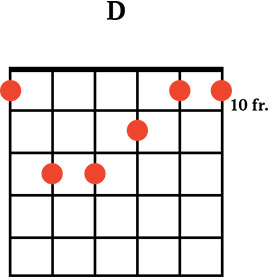

1st step:
C major scale: C D E F G A B — Root D: D E F G A B C D E F G A B C — F is the 3rd and A is the 5th.2nd step:
D D# E F F# G G# A A# B C C# 1 2 3 4 5 6 7 8 9 10 11 As we can see we already found the right notes so no need to check the semitones with flats. D major notes are: D F# A
C minor (Cm)
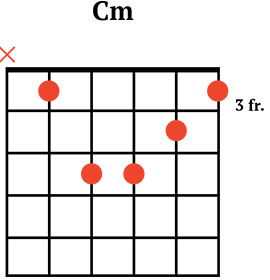

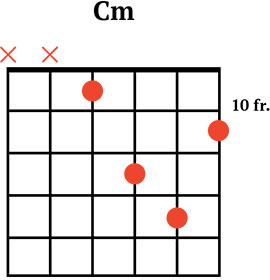
1st step:
C major scale: C D E F G A B C D E F G A B — E is the 3rd and G the 5th2nd step:
C C# D D# E F F# G G# A A#
1 2 3 4 5 6 7 8 9 10
C Db D Eb E F Fb G Ab A Bb
1 2 3 4 5 6 7 8 9 10
So C minor notes are: C Eb G
Remember that minor chords have a minor 3rd = 3 semitones.
So knowing that and the right note (E) we already can see that the correct note would be Eb and not D#.
The 5th is natural so it’s the same on both scales. If you’re having trouble with this, try using our detailed guide to learn guitar scales.
Seventh Chords
So far we have gone over basic chords, which are majors, minors, and dominant. These are the most important first chords to learn on the guitar.
Actually, we learned about the 7th note, but only in dominant chords, but we can add the 7th to majors and minors too. There is also another type of chord called diminished.
Actually, we have half-diminished 7th and diminished 7th.
To put it simply, major chords will have a major 7th note and minors will have a minor 7th note. (Same as dominant, except that minors have a minor 3rd). Half diminished has a root, minor 3rd, diminished 5th and minor 7th. And diminished 7th chords consists of: root, minor 3rd, diminished 5th and diminished 7th.
Major 7th Chords
Major 7th chords will have: Major triad (Root, major 3rd, perfect fifth and major 7th)
Ex: C major 7th (Cmaj7): C, E, G, B

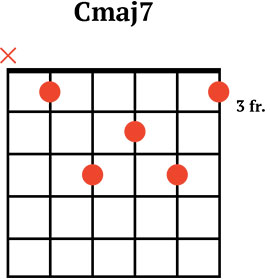

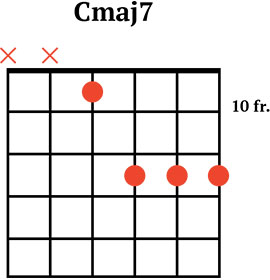




Minor 7th Chords
Minor 7th chords will have: Minor triad (Root, minor 3rd, perfect fifth and minor 7th)
Ex: C minor 7th (Cm7): C, Eb, G, Bb

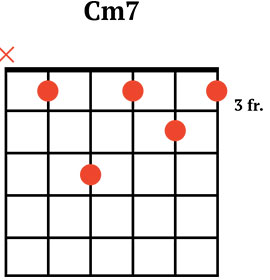
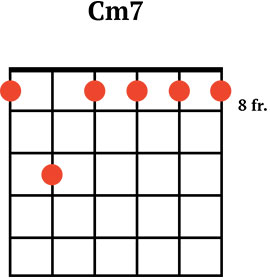
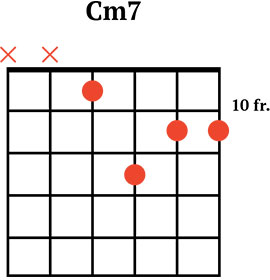




Let’s recap on how to get the 7th note, at least the minor 7th:
7th minor interval is at 10 semitones above any given note, in our case (dominant chord) 10 semitones above the root. So for example, from A would be G. (A: A# B C C# D D# E F F# G).
So this works also for the minor chords. If we have an A minor 7th, our 7th note will be G.
The resultant minor 7th chord is (Am7): A C E G
Dominant (A7): A C# E G
Major 7th will be at 11 semitones about any given note.
So let’s find the major 7th for an A major chord.
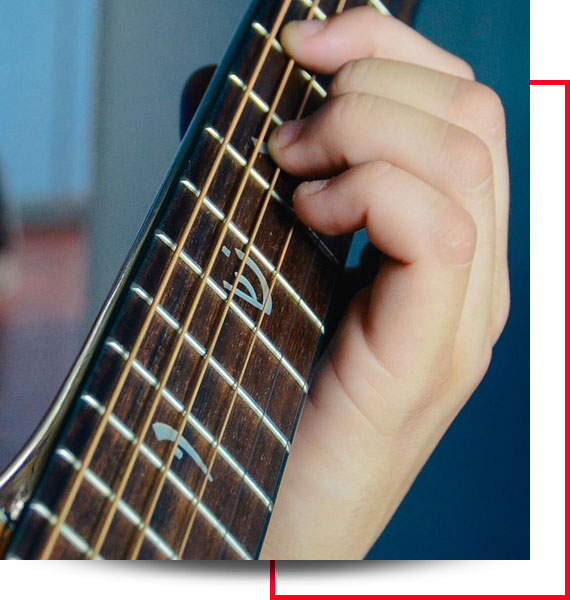
Remember 1st step:
Use the C major scale: C D E F G A B now let´s find the 7th note starting from A: A B C D E F G 1 2 3 4 5 6 72nd step:
Count semitones in a chromatic scale starting from the root, first with sharps and then with flats:
A A# B C C# D D# E F F# G G#:
0 1 2 3 4 5 6 7 8 9 10 11
A Bb B C Db D Eb E F Gb G Ab
0 1 2 3 4 5 6 7 8 9 10 11
So since we already know that the note is G, no matter if it´s # or b we can see that our major 7th for the A Major chord is G#.
So A major 7th (Amaj7) has these notes: A C# E G#.




Let’s see a few more examples:
D major 7th (Dmaj7). Earlier we found the major triad (D F# A), so now let’s find the major 7th.
1st step:
D E F G A B C
1 2 3 4 5 6 7
So we know that C is the 7th note of D. So now let’s check if it is sharp or flat.
2nd step:
D D# E F F# G G# A A# B C C# :
0 1 2 3 4 5 6 7 8 9 10 11
D Eb E F Gb G Ab A Bb B C Db
0 1 2 3 4 5 6 7 8 9 10 11
So since we already know that the note is C, no matter if it’s # or b we know that our major 7th for D Major is C#. So D major 7th (Dmaj7) has the notes: D F# A C#




Earlier we checked the notes for F7, now let´s find the major 7th (Fmaj7)
1st step:
F G A B C D E
1 2 3 4 5 6 7
So we know that E is the 7th note of F. So now let’s check if it is sharp or flat.
F F# G G# A A# B C C# D D# E :
0 1 2 3 4 5 6 7 8 9 10 11
In this case, we can see that our note is natural.
This is because in a diatonic major scale there
are 2 natural semitones, from B to C and from E to F.
F Gb G Ab A Bb B C Db D Eb E
0 1 2 3 4 5 6 7 8 9 10 11
Fmaj7 notes: F A C E


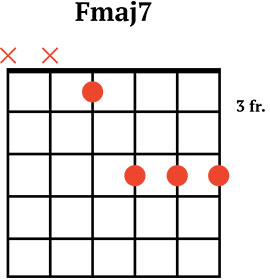
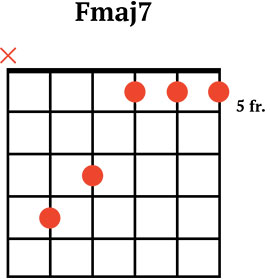
Minor/Major 7th Chords
Minor/Major 7th chords will have: Root, minor 3rd, perfect fifth and major 7th)
Ex: C minor/major 7th (Cm/maj7): C, Eb, G, B

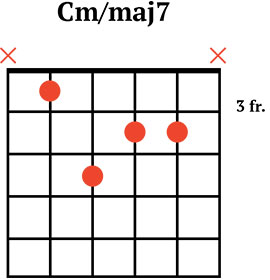
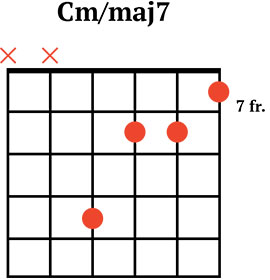
Diminished Chords:
Half diminished: Cm7b5
1st step:
C D E F G A B
1 2 3 4 5 6 7
So we know that E is the 3rd note of C. So now let’s check if it is sharp or flat.
2nd step:
C C# D D# E F F# G G# A A# B :
0 1 2 3 4 5 6 7 8 9 10 11
We know that a minor chord has a minor 3rd, so that E should be flattened along with the 5th, G, and the 7th B.
C Db D Eb E F Gb G Ab A Bb B
0 1 2 3 4 5 6 7 8 9 10 11
Cm7b5 notes: C Eb Gb Bb
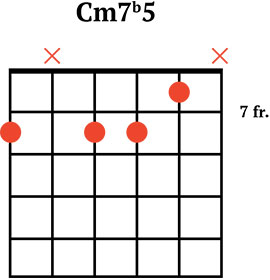

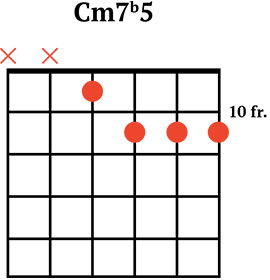
Diminished 7th: Cdim7 or Cº7
1st step:
C D E F G A B
1 2 3 4 5 6 7
So we already know that E is the 3rd note of C, G is the 5th and B is the 7th. So this chord is similar to the half Diminished but it has a diminished 7th.
2nd step:
C C# D D# E F F# G G# A A# B :
0 1 2 3 4 5 6 7 8 9 10 11
We know that a minor chord has a minor 3rd, so that E should be flattened along with the 5th, G, and the 7th B.
C Db D Eb E F Gb G Ab A(Bbb) Bb B
0 1 2 3 4 5 6 7 8 9 10 11
Cdim7 notes: C Eb Gb Bbb
If Bb is the minor 7th, how can we flatten that Bb? We just add another b, so we get a Bbb, which sounds the same as an A, but we already learnt the Enharmonics.



How to Learn Guitar Chords: Extended Chords
Chords with added notes beyond the 7th. Ninth, Eleventh, or Thirteenth, are extended chords.
The structure of these chords will be the same, by triads.
So if we have a C major chord with all the extended notes, we will have this:
C D E F G A B C D E F G A B C = Cmaj13
1 2 3 4 5 6 7 8 9 10 11 12 13 14 15
1 2 3 4 5 6 7 8
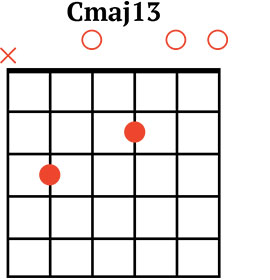

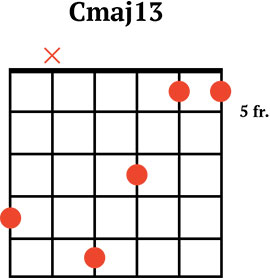
Notice that the 9th is the same as the 2nd note but an octave higher, the 11th is the same as the 4th and 13th same as the 6th. Both an octave higher.
So from each degree or note of the major scale, if we add all the extended notes, we will get different types of extended chords.
First of all, let´s see the chords that we can get from C major scale or tonality:
I II III IV V VI VII
Cmaj7 Dm7 Em7 Fmaj7 G7 Am7 Bm7b5
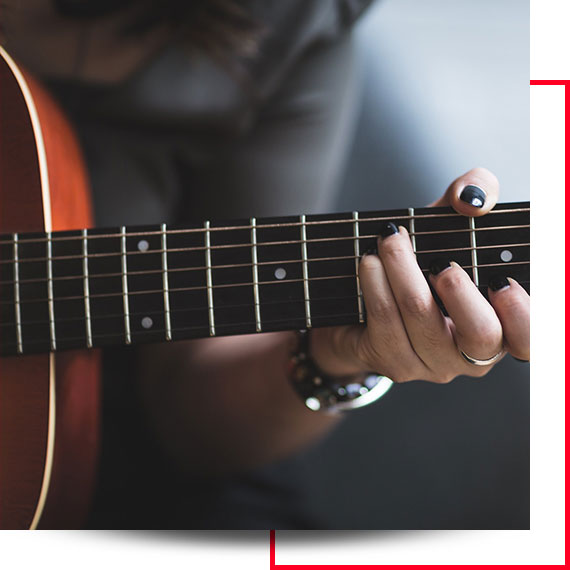
This is the same for any major key, it just changes the note names. For instance, a IV chord will be always Maj7, a VII will be m7b5, etc. Of course, this is theoretically speaking. A composer can change any of these rules, but you know the saying, before breaking the rules we have to know them.
So that means that each one of these extended notes can have different qualities. Depending of the interval variations from the diatonic scale.
So these extended notes can be:
As the 2nd note, the 9th is the same but 1 octave higher, so it can natural (major) or b (minor).
It also can be augmented (#9)
11th: Is the same as the 4th degree of the diatonic scale, but 1 octave higher.
It can be perfect (11) or augmented (#11)
13th: This one is the same as the 6th degree or note from the diatonic scale but 1 octave higher. It can be major (6 or 13) or minor (b6 or b13). Those notes would be at 9 or 8 semitones, respectively.
So now, if we look for the extended notes for each of these chords, we will get different types of extended chords.
Let´s make a list with all 7 chords with their extensions:
We already checked the 1st one. (Cmaj13).
Dm7: D E F G A B C D E F G A B C D = Dm13
1 2 3 4 5 6 7 8 9 10 11 12 13 14 15
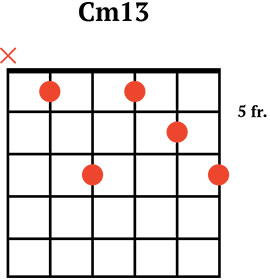


Em7: E F G A B C D E F G A B C D E =
1 2 3 4 5 6 7 8 9 10 11 12 13 14 15
Em7b9b13
(b9 and b13 because of the natural semitones from E to F and B to C)

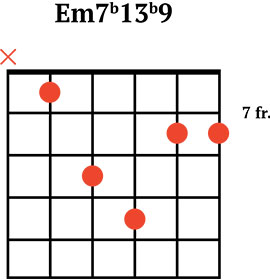
Fmaj7: F G A B C D E F G A B C D E F =
1 2 3 4 5 6 7 8 9 10 11 12 13 14 15
Fmaj13#11
(From F to B there’s an augmented 4th or 11th, so we will have a #11)
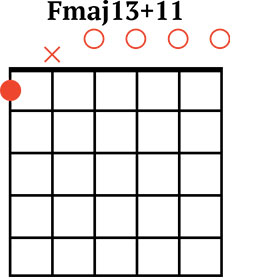


G7: G A B C D E F G A B C D E F G
1 2 3 4 5 6 7 8 9 10 11 12 13 14 15
= G13

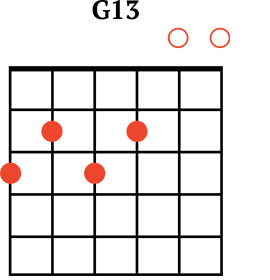

Am7: A B C D E F G A B C D E F G A
1 2 3 4 5 6 7 8 9 10 11 12 13 14 15
= Am11b13
(From A to F, there´s minor 6th or 13th so we will have a b13th)
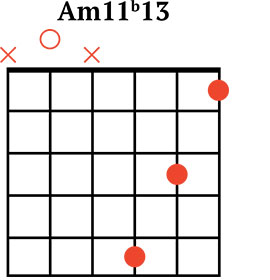

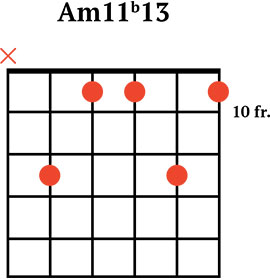
Bm7b5: B C D E F G A B C D E F G A B
1 2 3 4 5 6 7 8 9 10 11 12 13 14 15
= Bm7b5b9b13
(Usually it´s impossible to play all the 7 notes. For 13th chords it’s common to omit the 5th, the 9th and 11th; especially for guitar since we only have 4 fingers).

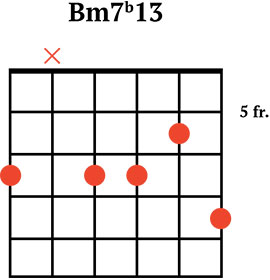


Their is one chord that we haven´t checked yet. The 7th degree or note from the diatonic major scale is a minor b5 or also called half diminished. Diminished 5th is 6 semitones above the root.
A diminished chord is built by a diminished triad (root, minor 3rd and diminished 5th) plus a diminished 7th. Remember that minor 7th was at 10 semitones, so diminished is at 9 semitones. That´s the same distance as a major 6th, so they will be enharmonics.
For instance, a C diminished chord (it can be notated like Cdim or Cº) would have the next notes: C Eb Gb Bbb (yes, it has a B double flat, and that’s because from B to C there´s already a natural semitone). Let´s count:
C Db D Eb E F Gb G Ab A Bb B C
0 1 2 3 4 5 6 7 8 9 10 11 12
So at 9 semitones we have A, but we need the 7th note (B) so to get that we need to flatten the Bb, so we get Bbb (which its enharmonic is A)
Ok, so let´s come back to our Bm7b5b9b13: It will have a b9 because from B to C there´s a natural semitone, that would be a minor 2nd or 9th.
What about the b13 (or b6), let´s count:
B C C# D D# E F F# G G# A A# B =
0 1 2 3 4 5 6 7 8 9 10 11 12
As we can see, the 6 or 13 (G) is at 8 semitones, meaning that Bm7b5 has a B13.
If all of this is too advanced, it may be better to start from square one and see the best way to learn guitar starting from the basics.
Augmented Guitar Chords
These chords are like the opposite of Diminished chords, since they are minor triads with a diminished 5th. These ones are major triads with an augmented 5th. (The augmented 5th will be at 8 semitones, same as a minor 6th)
So they have: Root, major 3rd and augmented 5th.
C augmented (Caug or C+) = would have the following notes: C E G#
Let´s count:
1st step:
C major scale: C D E F G A B — C D E F G A B — G is the 5th 1 2 3 4 52nd step:

C C# D D# E F F# G G# A A# B C
0 1 2 3 4 5 6 7 8 9 10 11 12
– We can easily see that G# is the correct note.


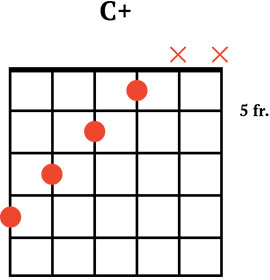

Let’s look at a few more examples:
A augmented (Aaug or A+) = would have the following notes: A C# E#
1st step:
C major scale: C D E F G A B — A B C D E F G — E is the 5th 1 2 3 4 5 6 72nd step:
A A# B C C# D D# E F F# G G# A
0 1 2 3 4 5 6 7 8 9 10 11 12
So at 8 semitones we get an F, but we know that our 5th is E, so we need to sharpen it. So we get an E#, which its Enharmonic is F.




D augmented (Daug or D+) = would have the following notes: D F# A#
1st step:
C major scale: C D E F G A B — A B C D E F G — A is the 5th 1 2 3 4 5 6 72nd step:
D D# E F F# G G# A A# B C C# D
0 1 2 3 4 5 6 7 8 9 10 11 12
– We can easily see that A# is the right note.
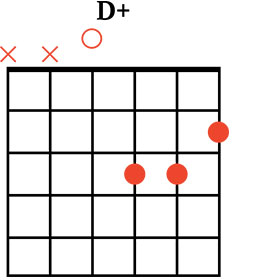


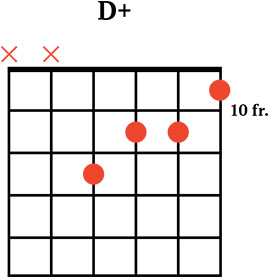
Suspended Chords
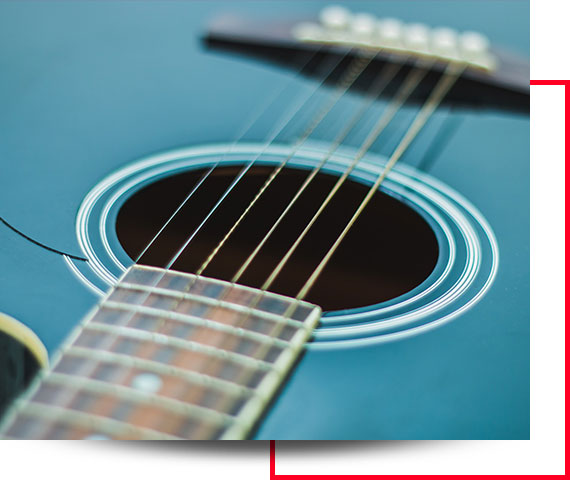
These are chords that don’t have thirds, they are replaced by a perfect 4th. Sometimes the 3rd is replaced by a major second. We can find these chords as sus4, sus2 or just sus, although it’s more common that the 3rd is replaced by a 4th.
This means that these chords are neither major nor minor, but they create a characteristic open sound.
So the basic triad is built by a Root, perfect 4th & perfect 5th (Sus4) or Root, major 2nd & perfect 5th (Sus2). A perfect 4th is at 5 semitones above the root.
Let´s see a few examples:
Csus4 = C F G
C D E F G A B
1 2 3 4 5 6 7

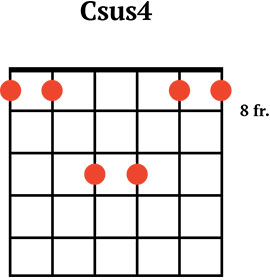


Csus2 = C D G
C D E F G A B
1 2 3 4 5 6 7

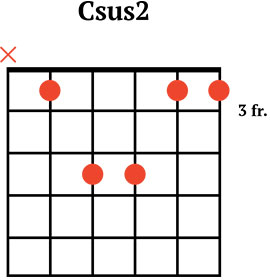
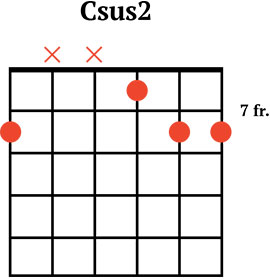
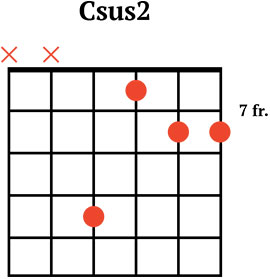
Asus4 = A D E
A B C D E F G
1 2 3 4 5 6 7


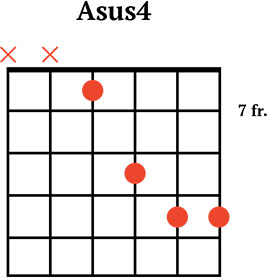
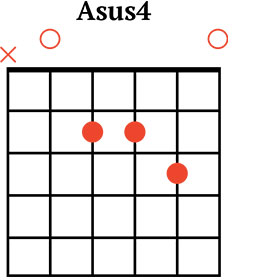
Asus2 = A B E
A B C D E F G
1 2 3 4 5 6 7
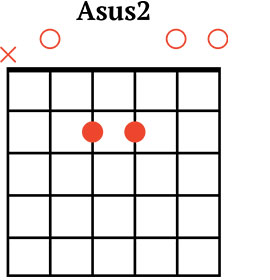
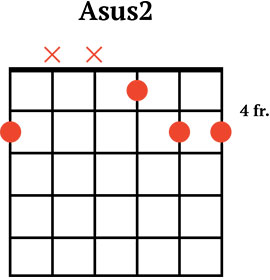
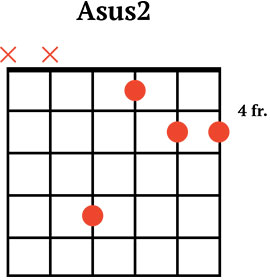

Suspended Dominant Chords on Guitar
There are mainly two types of sus dominant chords, dominant 7th sus4 (7sus4) and dominant sus9 (7sus9). These are important for having a complete understanding of how to play guitar chords.
7sus4 is just a basic dominant chord with a suspended 4th. It´s built by a Root, perfect 4th, perfect 5th and minor 7th.
7sus9 This is just the same as 7sus4 except by the adding of a major 2nd or 9th. So it´s built by a Root, perfect 4th, perfect 5th, minor 7th and major 9th.
Let´s see some examples:
C7sus4 = C F G Bb
1st step:
C major scale: C D E F G A B — C D E F G A B — F is the 4th 1 2 3 4 5 6 72nd step:
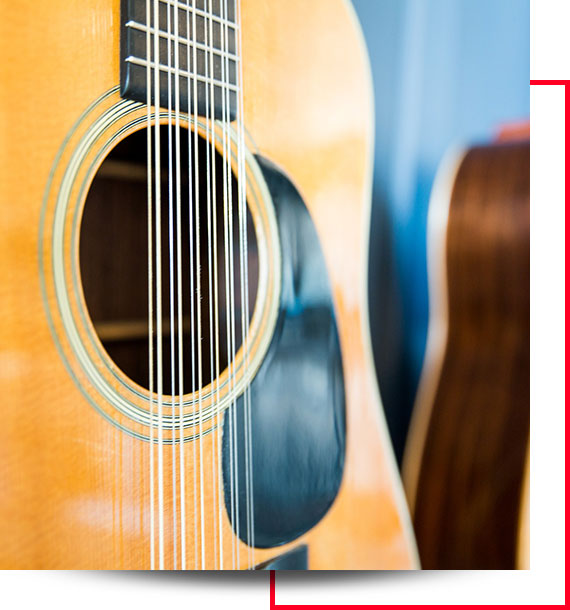
C C# D D# E F F# G G# A A# B C
0 1 2 3 4 5 6 7 8 9 10 11 12
– We can easily see that F is the right note.




F7sus4 : F Bb C Eb
1st step:
C major scale: C D E F G A B — F G A B C D E — So B is the 4th 1 2 3 4 5 6 72nd step:
F F# G G# A A# B C C C# D D# E –
0 1 2 3 4 5 6 7 8 9 10 11 12
So 5 semitones will give us an A# but we know that the 4th is B. We don’t have to write down the chromatic Scale with flats to find that it should be B. We just look for the enharmonic. So it should be a Bb which is the Enharmonic of A#.



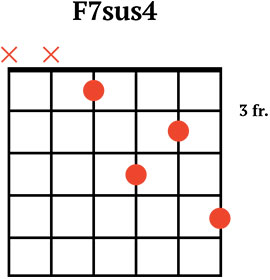
G9sus4 = G A C D F
1st step:
C major scale: C D E F G A B — G A B C D E F G A — So C is the 4th and A is the 9th. 1 2 3 4 5 6 7 8 92nd step:
G G# A A# B C C# D D# E F F# G =
0 1 2 3 4 5 6 7 8 9 10 11 12
So 5 semitones gives us a C and A is the major 2nd or 9th.
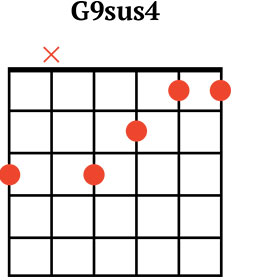
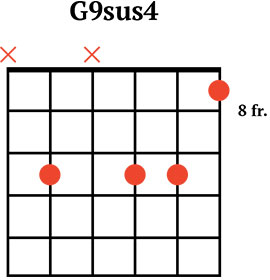

A9sus4 = A B D E G
1st step:
C major scale: C D E F G A B — A B C D E F G A G — So C is the 4th and A is the 9th. 1 2 3 4 5 6 7 8 92nd step:
A A# B C C# D D# E F F# G G# A =
0 1 2 3 4 5 6 7 8 9 10 11 12
So 5 semitones we give us a D and B is the major 2nd or 9th.

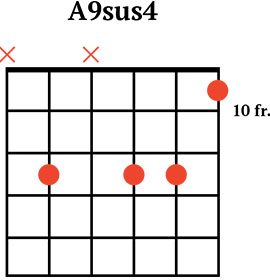
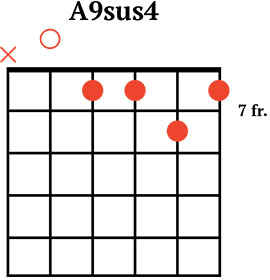
Add Chords or Added Tone Chords
Add chords are those that have a note added to the basic triad, of course it won´t be a 7th because in that case would be a seventh chord. The main notes, or most used notes are the 6th, the 9th, the 11th and the 13th. But remember that these ones are note extended chords since they don’t have the 7th.
For example, Cadd9. This means that we just add a 9th to a C major triad, hence the notes:
C E G D.


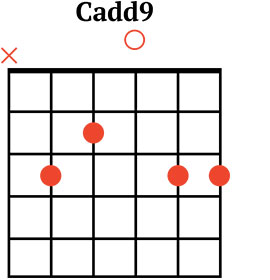
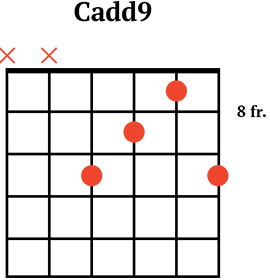
It also can be a minor triad, so Cmadd9, it just changes the 3rd, hence It also can be a minor triad, so Cmadd9, it just changes the 3rd, hence C Eb G D
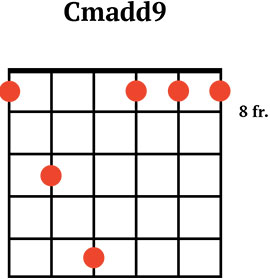

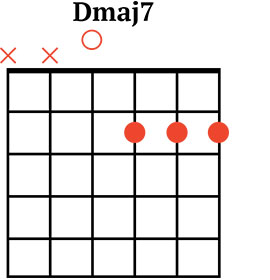
Another good example is an added 6th chord, for instance: Cadd6 or C6.
Their notes are: C E G A –



For C minor, Cmadd6 or Cm6 = C Eb G A
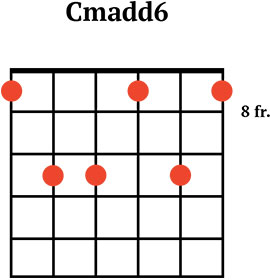

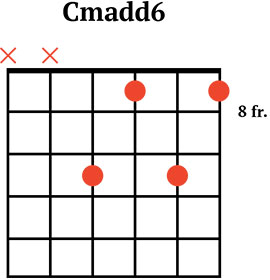
Another useful chord is the 6/9 chord. This is a triad (minor or major) plus the add of a major 6th and 9th.
Chord structure would be: Root, 3rd, 5th, 6th and 9th
C6/9 or C6add9 has these notes : C E G A D
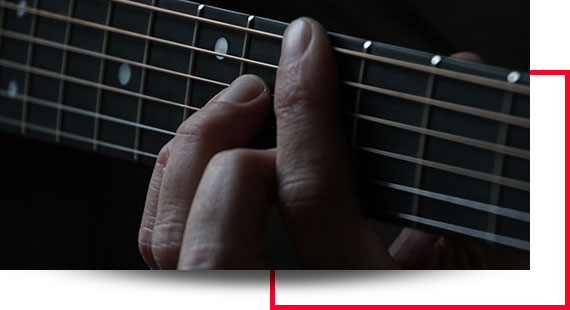

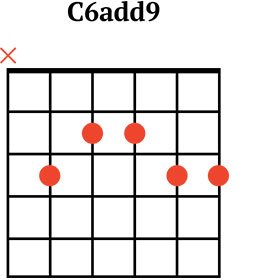

Cm6add9 : C Eb G A D

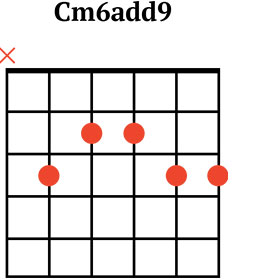

D6add9 : D F# A B E
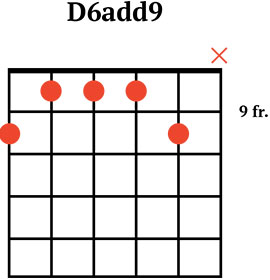
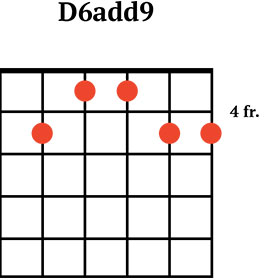

Dm6add9 : D F A B E

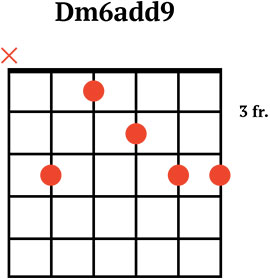
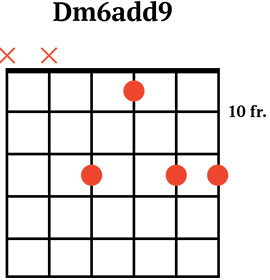
E6add9 : E G# B C# F#



Em6add9 : E G B C# F# … And so on….

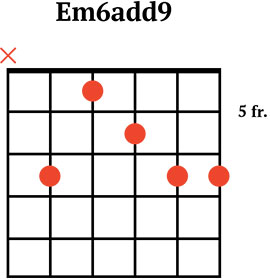
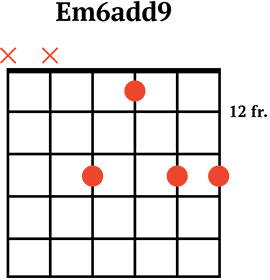
How to Play Guitar Slash Chords
The slash name comes from the symbol “/” that we use to write this type of chords.
It’s common to use this chord name for chord inversions.
Chord Inversions: This is when we change the order of the chord notes. A chord can have as many inversions as many notes it has besides the root. For example, if we take the C major chord we will have 3 notes, C, E and G. So we will have 2 inversions.
Besides the root position (C E G), we will have the 1st inversion, E G C and the 2nd inversion, G C E.
So, if we want to write a chord progression and we want to have C chord inverted, we will use the slash symbol.

C major, 1st inversion will be: C/E (meaning C with the bass in E, or C over E)
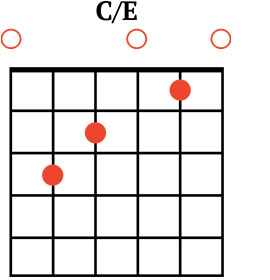
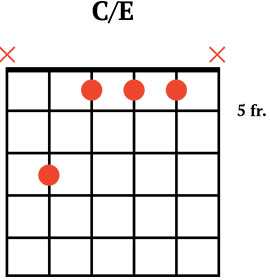
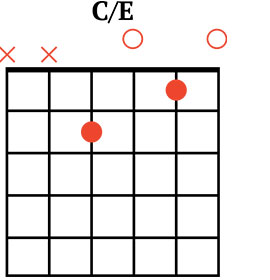
C major, 2nd inversion will be: C/G (meaning C with the bass in G, or C over G)
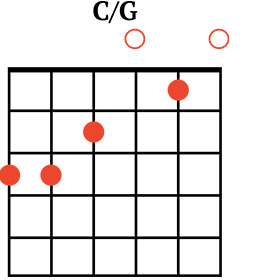
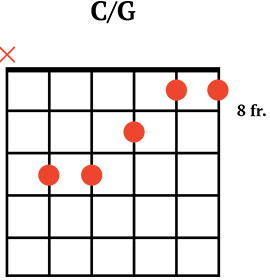

For seventh chords there will be a 3rd inversion since it has 4 notes.
For Cmaj7 we will have:
Root position: C E G B
1st inv: E G B C = Cmaj7/E
2nd inv: G B C E = Cmaj7/G
3rd inv: B C E G = Cmaj7/B




For Cm7 we will have:
Root position: C Eb G Bb
1st inv: Eb G Bb C = Cm7/Eb
2nd inv: G Bb C Eb = Cm7/G
3rd inv: Bb C Eb G = Cm7/Bb
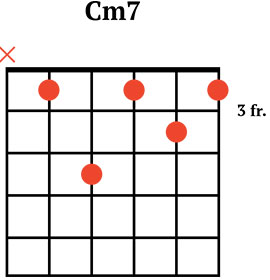



Of course, there are other uses for slash chords. There also can be non related chord notes on the bass. Depending of the chord type and music context.
One of the common uses could be for connecting chords with the bass notes chromatically. For example:
G D/F# Dm/F E // So we get chromatic notes with the bass, G F# F E.

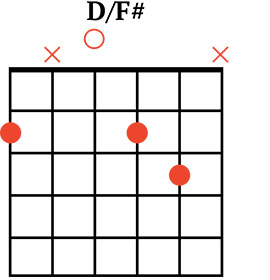
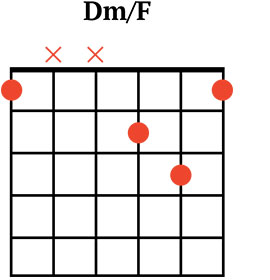

Another common use is for altered dominant chords. For instance, a dominant 9 sus4 could be seen as a slash chord.
Example in G: G9sus4 could be notated as F/G, both have the same notes. Sometimes musicians use slash chords to simplify it.

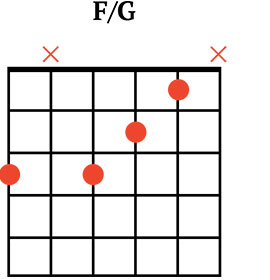
Learn Altered Guitar Chords
These chords are mainly used in Jazz music, and they refer to a dominant chord, which some of its notes are raised or lowered by a semitone.
Here´s a nice table where we can see the altered notes:
– b5th and/or #5th (the b5th could be notated as #11)
– b9th and/or #9th (b2, #2 or b3)
– b13th ( #5)
So these are some of the most used combinations: (Examples in G)
G7b9 : (G B D F Ab)
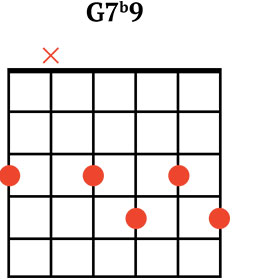
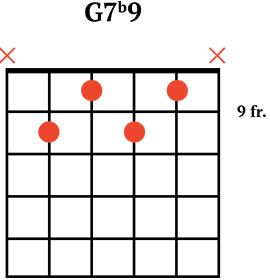

G7#9 : (G B D F A# – this chord is also known as the Hendrix chord).



G7b5 : (G B Db F)
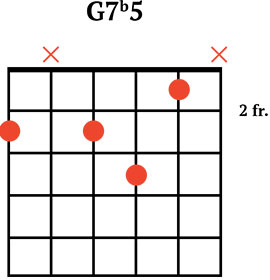


G9b5 : (G B Db F A)
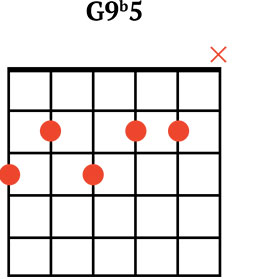
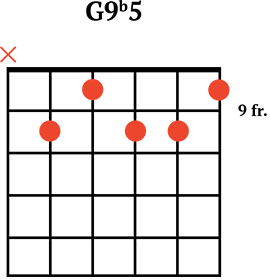
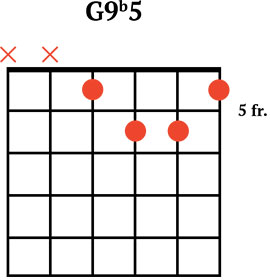
G7#5b9 : (G B D# F Ab)


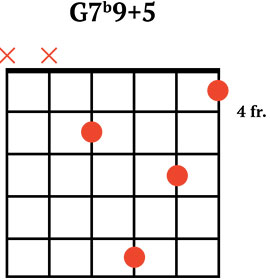
G9#5 : (G B D# F A)
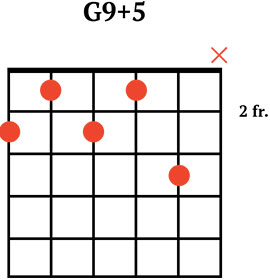


G13b9 : (G B D F Ab E)



Learning Chords on Guitar: Conclusion
We taught you how to play every major guitar chord in a step by step fashion from the basic chords up to the most complex chords.
Just understanding how to learn chords on guitar is not sufficient for you to be able to play guitar chords however. That takes the hard work of practicing until you have the finger movements memorized.
Refer back to how this beginner’s guide often to continue to learn guitar chords until you have them mastered. With a bit of dedication you’ll be playing chords like a pro in no time!
Guitar Chords Guide FAQ
Which guitar chords to learn first?
Open chords are the easiest chords to learn. People often asks which guitar chords to learn first, so if you are looking to play guitar you should start learning open chords. Those are the most basic guitar chords which are called that way because they use open strings, opposite to barre chords which are a lot more difficult to play. Guitar chords are really important because it’s what you will use to play songs. The most basic open chords at least 8: E minor, E major, A minor, A major, D minor, D major, C major and G major. The very first chord that you should start with is E minor. That’s the easiest chord to play. It just requires 2 finger on the fret board. The rest of the strings are open. The second chord to learn is E major. Pretty much the same than E minor but it just adds 1 finger. Third chord is A minor. This one has the same position than E major but in another group of strings. Once you can play those 3 chords, they could go on with any of the rest of those 8 chords. It’s important to know that once you can play those 8 chords, they will be possible to play literally thousands of songs.How many basic guitar chords are there?
The most basic chords are 8: Em, E, A, Am, Dm, D, C and G. Chords are a group of at least 3 stack notes which form different kind of harmonies. Actually there are literally thousands of guitar chords. From very basic ones to advanced. It’d be useless to count them, it’s more important to start learning from the basic to more advanced as you grow as musicians. Anyway, it depends the level of complexity of the chords. I´d say that there are 8 open chords that could be taken as the more basic ones. So if we are talking about basic chords, we could separate them in two categories and quality: Open and Barre chords, major & minors. Open chords are those which has at least 1 open string. Barre or bar chords are those which requires pressing down several strings on the fret board with 1 finger. Usually the index finger. The most basic and easy to play open chord is E minor. You just need 2 fingers to play it. If you are just learning the basic chords, you would need to start with the first 7 or 8 open chords. These guitar chords are: E minor, E major, A minor, A major, D minor, D major, C major and G major.How do you read guitar chords?
Vertical lines represent the strings, horizontal lines the frets and the dots the fingers. For a guitar beginner is really important to know how to read guitar chords. Nowadays with internet you can learn tons of chord charts, but first you will need to know how to read them. First, what is a chord? A chord is at least 3 stack notes played at the same time. There are several kind of chords, but the most important are major, minor and dominant. So a guitar chord chart is an image of a part of the fret board. You have to think it just as it was a standing up guitar neck. Therefore the vertical lines would be the strings and the horizontal lines are the frets. The vertical lines, starting from the left side is the 6th strings, being the 1st string the last the one on the right side. On top of the picture will be the name of the chord. If it’s an open chord, the first horizontal line will be thicker, which represents the nut of the guitar. The next horizontal line is the 1st fret, the next the 2nd and so on. If the chord is not open, like a barre chord, there will be an horizontal thick line in the middle of 2 frets. This bar is usually played with the index finger. Also for chords that are played in an upper place of the fret board, you will see a Roman number on the left or right side of the picture. It can go from I to XX, but its not common, usually it goes from I to XV Then you have the dots, which tells you where to place your fingers. Keep in mind, that there could be different type of charts. Some of them can have dots with ir without numbers. Those numbers indicate what finger (fretting hand) should you use on the different dots. The numbers goes from 1 to 4. 1 = index finger 2 = major finger 3 = ring finger 4 = pinky finger Depending of the chord chart, you can see a 0 or X on top or bottom of the each string. The 0 means open strings, and the X means that you don’t have to play that string.Can you play the guitar without a pick?
A guitar can be played with pick or with your fingers. Can you play the guitar without a pick? That´s a pretty common question for the beginner guitar player. Of course, you can play with or without a guitar pick or plectrum. The music style could determinate the style of playing. They are different techniques. Finger style (no pick) is commonly used in classical guitar. Also in country or bluegrass music. But it’s also common to use a combined technique for country or bluegrass. They use a thumb guitar pick plus the rest of the fingers. Finger style is more used to play melody and chords together, that technique is called chord melody playing, which is usual is jazz music. Another thing you can play is 2 or more voices at the same time, something that could be impossible if you play with a pick. So we could say that a pick is more used for strumming or lead playing. Lead playing means guitar soloing with different techniques, like alternate picking, sweep picking, legato playing, etc. There are also different kind of picks, more thin, more thick, bigger, smaller. Thin picks are used often for strumming but it’s all about personal taste.How do you read guitar tabs?
Horizontal lines represent the strings and the numbers the frets. How do you read guitar tabs? That’s one of the most frequent questions for any beginner guitar player. Guitar Tab or tablature is an easy way of writing music for stringed instruments. Especially for guitar and bass. The difference with traditional music notation is that you don’t need to know how to read actual music. Anyone can use this system, which is based in lines, which represents the strings and numbers on them, indicating the frets. To recap, the horizontal lines represents the strings and the numbers the frets. If there’s a 0 means that you have to play an open string. So the upper line is the thinnest string (1st one) and the one in the bottom is the thickest string (6th one). Therefore if it’s a guitar tab, it will have 6 lines. If it’s a bass tab, could have at least 4 lines, but also 5 or 6. Depending on the tabs, they can be pretty basic, with just lines and numbers. Some others could be more advanced, which comes with the exact fingers you should use on each fret, plus the rhythm with traditional music notations and the chords on top.How do you strum a guitar with your fingers?
Simulating a pick with your fingernails and using the thumb. How do you strum a guitar with your fingers is an usual question that any beginner player has. Strumming is a technique that is commonly played with a pick or plectrum, but also you can play it with your fingers. There are several ways to do it: First one you want to try is like holding a pick but just use your index fingernail. Second way is kind of the same as the first one, but you will use your thumb. Third way, you can use both fingers, using one for strumming down and the other one for strumming up. Fourth way, you can also use the tips of the index, major and ring finger to strum. Fifth way, you can use the 3 fingers of the previous example, plus the thumb. This kind of strumming technique is used in Argentinian folk. I’m sure there could be more ways to strum, but the most advanced way is the flamenco technique. They have pretty complex rhythm figures and use all the fingers of the strumming hand, with tons of variations. For all the strumming ways, the most important thing is to get a good volume and tone out of the guitar and also have a very relaxed wrist and hand.What is a major guitar chord?
A major chord is built by a root, major 3rd and a perfect fifth. A guitar chord is a group of at least 3 notes played simultaneously. Those chord notes can also be played sequentially, which name is arpeggio. The most basic chords are majors, minors. If you know these 2 kind of chords, you will be able to play literally thousands of songs. So the basic chord structure or triad is formed by a root, a third and a perfect fifth. The difference between a major chord vs minors is that majors have a major third, and the minors a minor third. So what is a major guitar chord? Major chords have a unique sound, subjectively we can say that it reflects happiness. On the other hand, minor represents darkness and sadness. Major chords are some of the first things that any beginner should start with. Easy chords like C , D, E, A or G major. Also, the way that major chords or triads are written are with just a letter. For example: “C” (C major) , it doesn’t require any another symbol to indicate that it’s a major chord. Different than minors, which requires the letter “m”, for example: “Cm”, meaning C minor.How do you play the chords on a guitar?
The first step is learning most basic open chords, like E minor. Playing chords on guitar is one of the first things that any beginner should start with. There are thousands of chords, but you should start with the most simple ones. And those are called open chords. That means that they will have one or more open strings. So how do you play the chords on a guitar? The first you need to know is the name of the strings. Starting from the thinnest, their names are: 1st string: E (high E) 2nd string:B 3rd string: G 4th string: D 5th string: A 6th string: E (low E) So once you know the name of the strings, next step is to put your fingers on the strings in the right fret. The frets are those metal bars that are placed on the fret board. If you are learning the basic chords, you will be playing in the first 3 or 4 frets. The first fret is the one that follows the nut (the nut is the plastic piece where the strings rest from the tuning machines to the neck) Another important thing is to know how to call each fingers. We will call them with numbers: Number 1: Index finger Number 2: Major finger Number 3: Ring finger Number 4: Pinky finger Another thing I recommend you is to learn how to read chord charts. That will help you to read all the chords you want to learn.What is standard guitar tuning?
Standard tuning is the “normal” way of tuning a stringed instrument. A frequent question among beginner guitar players is what is standard guitar tuning. Standard guitar tuning is the most common way of tuning a stringed instrument, mainly guitar (any type), bass guitar and piano. There are a lot of different tuning, but the “normal” way is, by convention, from the lowest note to the highest, ordered as E, A, D, G, B, E. Each of those notes have an specific audio frequency that changes depending on the height of each note. Most of guitar players use standard tuning, but some of them, depending on the style of music, uses what it’s called “alternate” or “alternative tuning”. Some of those alternatives tuning use open strings to form different chords or have “dropped” notes. This last term “drop” means that some of the strings are tuned lower.What do the X’s and O’s mean on guitar chords?
The X’s mean muted note or string. 0’s mean open string. Reading chord charts or diagrams is easy and you don’t have to know how to read standard music notation. There are different chord charts quality, usually some are more complete than others. The most complete ones have more details, like what fingers you should use on each string and frets. Also there are more details like what strings should be opened or muted. So what do the X’s and 0’s mean on guitar chords? For indicating an open string you will see a zero number (0) on top or bottom of the diagram, in the required string. (Strings are symbolized with vertical lines). Also you can see an “X” on top or bottom of the diagram, in the required string, meaning that the string don’t have to be played. Different to the “X” that is ON the strings in a guitar tab. (You can also read a chord in a tab) In tabs, the X which are on top of the strings, means “dead” or muted notes. So to make it clear, there are chord charts AND guitar tabs.What does an H mean on a guitar tab?
In a guitar tab, an H means hammer on. Reading guitar tabs or tablature is easy and you don’t have to know how to read standard music notation. Some tabs are more complete than others, so they will have more details, like what finger you should use on each string and fret. Also you will find details on how to execute each note, like different picking motions, techniques like tapping, legato (hammer on – pull off), slides notes, etc. Picking motions will be indicated with with a kind of “horizontal” brackets for Down strokes. And a “V” for Upstrokes. And what does an H mean on a guitar tab? Hammer on = “H” Also the “P” Pull off = “P” And the “T” Tapping notes will be indicated with a “””. And the “S”? Slide notes = “S” – the S could be accompanied with a “/” symbol.What are the power chords on guitar?
Power chords are built by a root and a perfect 5th. A frequent question among beginner guitar players is what are the power chords on guitar? Power chord is the name that fifth chords are known in popular music, especially in rock, hard rock and metal genres. So fifth chords are very simple and easy to play. The most basic way of playing these chords is with just 2 notes. Those notes are the tonic, or root, and the fifth. The common way to write these power chords is with a number 5. Example C5. So what is a fifth? That means the fifth note of a diatonic scale. The common and usual popular music is based in the major scale. So if we take the C major scale, it has 7 notes, C D E F G A B. So the fifth note is G. So if we want to play a C power chord, it will have the notes C and G. (All examples will be in C) Also there are some variations. One of them is adding another tonic or root note an octave higher. So it will have C, G and C(1 octave higher). Another variation is by just adding another fifth note an octave lower. So it will have G(lower octave), C and G. You could find that chord under the name of C5/G. (the slash means “with the bass in…”) The lower 5th adds heaviness and aggressiveness. This kind of power chords are more used in metal extreme and progressive bands. Another variation would be a mixture of the last 2 examples. So we will add the lower fifth, plus the higher tonic. The result chord is G(low), C, G and C(higher octave). A more complex variation will apply a ninth note. Ninth is just a second an octave higher. So we have 1-C, 2-D, 3-E, 4-F, 5-G, 6-A, 7-B, 8-C, 9-D, etc… As you can see, both 2nd and 9th are the same note. So this variation will have a low 5th, root, 5th, and 9th . The notes will be: G(low), C, G and D. You could find that chord under the name of C5add9.Can you play power chords on an acoustic guitar?
You can play power chords on all kinds of guitars. Power chord is the name that fifth chords are known in popular music, especially in rock, hard rock and metal genres. So fifth chords are very simple and easy to play. The most basic way of playing these chords is with just 2 notes. Those notes are the tonic, or root, and the fifth. So can you play power chords on an acoustic guitar? Actually you can play power chords in any type of guitar. Although is more common to play on the electric, they can be also played in acoustic guitar. But the whole point of these kind of chords is to play them with a distorted sound. And for that you will use your electric guitar with an amplifier and maybe some distortion pedal box. Of course, it’s possible to play with the same amp and pedals with an acoustic guitar that you can plug in, but it’s not very common. It’s not usual to play that type of chords with an acoustic guitar either. You want to sound the fullest and bigger you can with just an acoustic guitar, so the idea will be to play full chords, using more than 2 or 3 notes.What are the bar chords on guitar?
Bar chords requires one finger to press all strings down on a single fret. One of the most frequent questions among beginner guitar players is what are the bar chords on guitar? Bar or barre chords are the most difficult ones to play for the beginners. To play these bar chords you need to use one finger to press, usually, all the strings down on one fret. Then, with the rest of the fingers, you will commonly play an open chord shape. Actually, what you are doing with this bar finger is playing the role of the nut (the plastic piece, where the strings rest, that is placed where the head and the neck of the guitar joins). So imagine that you are moving the nut all along the fretboard. So the idea is to be able to play open chord shapes everywhere on the neck. The same thing, but without doing the bar with your first finger, you can do with a device called “Capo”. This way you can literally play open chords all over the fretboard. The Capo is more commonly used by singers who likes to play guitar while singing.What is a suspended chord?
Suspended chords are those ones that replaces the 3rd for a perfect 4th or major 2nd. A suspended guitar chord is a pretty common chord which you can find in most of the songs. Especially the suspended 4 chord. There could be also suspended 2, but not too often. So What is a suspended chord? A suspended chord is a bit different from the basic major or minor chord. The difference is that they don’t have the third. This is omitted by a perfect fourth or major second. For example, a C suspended 4 will have the following notes: C, F and G – the way of writing it is: Csus4 And a C suspended 2 will have: C, D and G. = Csus2 The characteristic of these kind of chords is their open sound which creates some tension, because of the dissonance between the 4th and the 5th and the 2nd with the root or tonic.Who invented the power chord?
Power chords was originally played on “Rumble” by Link Wray. Power chord is the name that fifth chords are known in popular music, especially in rock, hard rock and metal genres. So fifth chords are very simple and easy to play. The most basic way of playing these chords is with just 2 notes. Those notes are the tonic, or root, and the fifth. The common way to write these chords is with a number 5. Example C5. So who invented the power chord? Some people say that the first power chord was played in the classic blues rock instrumental song from 1958, called “Rumble” by the great Link Wray Later on, power chords started to gain popularity, especially in rock, hard rock and metal music styles.How do you play an E chord on guitar?
Put your index finger on 3rd string, 1st fret, major on 5th string, 2nd fret and ring finger on 4th string, 2nd fret. E major is one of the easiest chords to play on the guitar. If you are just learning guitar, this should be at least the second chord you want to try. A chord is a group of at least 3 stack notes played together or in sequence. There are two main kind of chords for a guitar, open and barre chords. So this E major chord is an open chord. Of course that it can be played as barre chord too, but you will get the fullest sound of it as an open chord. So how do you play an E chord on guitar? Here’s some guides on how to play this easy guitar chord: First if all, it’s important to know that each finger of the fretting hand will have a number. Index finger is = 1 Major finger = 2 Ring finger = 3 Pinky finger = 4 So place your 1st finger on the third string, first fret. 2nd finger on the fifth string, second fret. 3rd finger on the fourth string, second fret. Now, it’s really important that you don’t touch the strings that you are not supposed to press down, letting the open strings sound clean. This is one of the main things to deal with for any beginner. Ok, so once you put your fingers on the right strings and checked that every string sounds clean, you can strum all six string.How do you play an F bar chord on guitar?
Press all string down with your index finger (barre) on 1st fret, major on 3rd string, 2nd fret, ring finger on 5th string, 3rd fret and your pinky on 4th string, 3rd fret. F is one of the most difficult guitar chords to play for any beginner. And that’s because F is in the category of barre chords. As I just said, bar or barre chords are the most difficult ones to play for the beginners. To play these chords you need to use one finger to press, usually, all the strings down on one fret. Then, with the rest of the fingers, you will commonly play an open chord shape. So there are several ways to play an F chord, but the most common way is the one in the first fret. There’s a cool way to understand barre chords, so imagine that your bar finger plays the role of the nut (the plastic piece, where the strings rest, that is placed where the head and the neck of the guitar joins). So imagine that you are moving the nut all along the fretboard. The idea is to be able to play open chords shapes everywhere on the neck. So this F chord, will have the same chord shape than an E major chord, but one fret up. But you can’t move the nut, so you have to do the bar with your first finger (index finger) So how do you play an F bar chord on guitar? Here’s the finger positions: 1st finger (index) barre on first fret. 2nd finger (major) on the third string, second fret. 3rd finger (ring) on the fifth string, third fret. 4th finger (pinky) on the fourth string, third fret. It’s really important that you don’t mute the strings that you are not supposed to press down, the idea is to get the cleanest sound you can.What is the root note?
The root or tonic is the most important and lowest note in a basic triad. One of the most frequent questions among beginner guitar players is what is the root note? The root or tonic in a chord is the main and most important note. It’s the note that gives it the name. Some people gets confused because they think that the root is the lowest note in music staff or tab. It is the lowest note in a basic chord structure, which is formed by a root, a third and a fifth. That’s the basic triad, but it can get more complex by adding more notes, like a 6th, 7th, 9th, 11th, 13th , etc. But also, the chords can be inverted. So in music theory, this is called “inversions”. This means that the order of the notes can be inverted. But the root will always be the root. For example, C major has 3 notes, C, E and G. So we can see that a C major can have 2 inversions. 1st inversion is: E, G and C And 2nd inversion is: G, C and E As the chords get more notes, it will have more inversions, for example a Cmaj7 has the notes: C, E, G and B – So after the root, it has 3 notes, therefore it will have 3 inversions: 1st inversion: E, G and C 2nd inversion: G, C and E 3rd inversion: B, C, E and GHow long does it take to learn how to play the guitar?
It depends on a few points, like how much you practice. One of the most frequent questions among beginner guitar players is how long does it take to learn how to play the guitar? That’s a good question, but pretty generic. The answer seems obvious but it’s what really is: “It depends” Learning how to play the guitar depends mainly on how much time you practice. That’s the main key… But also there are other factors. One of them is natural talent. There are students that has more ability to learn how to play the guitar than others, that’s a reality. Another huge fact, is the goal you want to achieve. If you want to strum easy songs on the acoustic guitar, it won’t take you much time to get it. Practicing at least 1 hour a day, you should be playing a few songs in a couple of weeks. But if your goal is to learn jazz guitar or shred, it will take you several years. But again, practice time is everything. BUT… another key thing is what and how to practice. Getting a good guitar teacher would be ideal. But nowadays is easier to learn with all the information available in the internet. The problem with that tho is that the amount of info is so big that you end up overwhelmed. That’s why having a guitar teacher is such a good option.Is acoustic or electric guitar harder?
Acoustic guitars are a bit harder to play. Playing guitar is not an easy thing to learn, whether they are electric or acoustic. But is acoustic or electric guitar harder? Of course there are some differences. Acoustic guitars are a bit harder to play because they have heavier string gauge. Another key thing is that the basic acoustic guitar don’t have mic to amplify it, so you need to get a good sound without plugin it. Also keep in mind that there’s two big acoustic guitar categories: The common acoustic guitar with steel strings, which is usually played with pick or plectrum. But also finger picking, especially in country guitar music. These guitars are used in popular music like country, pop, folk, etc. The other kind of acoustic are classical guitars. These have nylon strings and the neck is wider and bigger, which make them more difficult to play than the electric guitar. Classical guitars are used for classical music. Also for folk, jazz and all its sub genres, etc. So to recap, electric guitar are easy to play because:- Smaller neck
- It can be amplified
- Lighter strings
What are the blues chords?
The basic blues chords are mainly dominant 7th chords. One of the common question is what are the blues chords? In blues music, the most basic chords are dominant chords. The basic dominant 7th chord is a major chord with a minor 7th. So it’s built by a root or tonic, a major third, perfect fifth and a minor seventh. For example, in C = C7, the notes would be: C, E, G and Bb. Of course dominant chords can get more complex, just by adding a flat or sharp fifth, a ninth, eleventh, thirteenth, etc. Also there are other blues chords. Minor blues, for example, will have minor chords, minor seventh chords and usually a dominant seventh chord in the turnaround, which is, basically, the ending of the chord progression. More complex blues harmonies will have more advanced chords, like diminished, altered chords, etc. But also, a simple blues song, could have basic major chords, like C, D, E, etc.What are the three chords of the blues?
In a basic blues chord progression, there are 3 main chords. The I, IV and V degrees. For ex: in C would be C, F and G. Many beginner guitarists may wonder, what are the three chords of the blues? A basic 12 bar blues chord progression, the most common chords are the tonic or root, the fourth and the fifth chord. The chord comes from the scale notes, which in music theory, they called degrees. Therefore a diatonic scale has seven degrees. These degrees are indicated with Roman numbers:I II III IV V VI VII – So in a blues song, the most basic common and used progression has the chords from the I IV and V degrees. For example a chord progression in C will have: The root or tonic C, the fourth (IV) F and the fifth (V) G. Actually, in a lot of other music genres, like pop, rock, etc, the I IV V are also the most important degrees.How many chords are in the 12 bar blues?
The most basic 12 bar blues progression has 3 chords, commonly known as Tonic (I), Forth (IV) and fifth (V). If you love blues guitar, one of the first things you should know is how many chords are in a 12 bar blues progression? So the most common and basic 12 bar chord progression has just 3 chords. The root, the fourth, and the fifth chord. Theorically, the chords in a progression are indicated as degrees, using Roman numbers. So those 3 chords would be the I, IV and V degrees.What are the most common blues chords?
The most common blues chords are dominant seventh. Blues is one of the favorite music genres by the guitar players, especially electric ones. So one of the frequent questions among them is what are the most common blues chords? A basic and common 12 bar blues progression, which is the basic blues structure, has 3 chords. Usually dominant seventh chords. The chord degrees are the first degree (I), fourth (IV) and the fifth (V). But this is for a major blues. It can be minor as well. A basic minor blues will have the same form structure but the chords will be minors, except for the fifth (V) degree or chord, which is usually minor but dominant seventh at the end of the progression. So let’s see both options in the tonality of C. Major Blues: Root or tonic C7 (I), F7 (IV) and G7 (V). Minor Blues: Root or tonic Cm (I), Fm (IV) and Gm (V) (G7 ending) A major chord can have major chords instead of dominant seventh. Also both major and minor progressions could have more complex chords too. Like diminished, altered, extended chords, etc.What is a seventh chord?
A seventh chord is a chord built by a major triad plus a minor seventh. So what is a seventh chord? This is one of the most important chords in music. In harmony, represents the fifth (V) degree, which is the second more import chord after the tonic or root. It’s the chord that generate tension is a piece of music or song, so after this chord would go usually to the root. So it creates what it’s known as tension-release. In a music context, for example in C major, this would be: // G7 / C // or V7 – I In C minor, // G7 / Cm // or V7 – Im Seventh chords are also pretty common in blues music. Also they could get more complex, especially in jazz, fusion or brazilian music, like bossa nova. In those kind of music, it’s common to add a ninth, eleventh, thirteenth, or flat-sharp fifth, to the basic chord structure.What is the difference between a 7th and major 7th chord?
A 7th chord it’s basically a major triad plus a minor 7th and a major 7th has a major triad plus a major 7th. So what is the difference between a 7th and a major 7th chord? They are two different kind of chords. One is a major chord and the other a dominant or dominant seventh chord. Both chords have a major triad, but the major kind has a major seventh (maj7) and the dominant has a minor seventh (7). So let’s see the notes of each chord in the tonality of C: C major seventh (Cmaj7) is built by a root or tonic (C), a major third (E), a perfect fifth (G) and a major 7th (B) C dominant seventh (C7) is built by a root or tonic (C), a major third (E), a perfect fifth (G) and a minor 7th (Bb). It’s important to know that these chords can get more complex by adding additional notes or flatten or sharpen some of their notes. For example, C7b5, Cmaj7#5, C7b9, Cmaj9, etc.What is the ninth of a chord?
A ninth chord is a chord with an interval of ninth, which is the same than a second one octave higher. So what is the ninth of a chord? The ninth is known as an extended note. This means that this note is added to the basic triads or seventh chords. So the ninth can be in different kind of chords, like majors, minors, dominant 7th, altered, etc. If the ninth is in a basic triad major or minor, it will be as an add chord and it will be a major ninth. For example in C: Cadd9: C, E G and D or Cmadd9: C, Eb, G and D Same with major or minor 7th chords, it will add just the seventh: Cmaj9: C, E, G, B and D Cm9: C, Eb, G, Bb and D In a dominant 7th chord, depending on its complexity, the ninth can be major, minor or augmented. Examples in C: C9: C, E, G, Bb and D C7b9: C, E, G, Bb and Db C7#9: C, E, G, Bb and D#What is a major 7 chord?
A major 7 chord is just a major triad with the add of a major seventh. So what is a major 7 chord? A major 7th chord is the category of the seventh chords. A seventh chord has at least 4 notes – those are the root or tonic, the third, the fifth and the seventh. So a major chord have a major third and seventh. So in C would have the following notes: Root or tonic: C Major third: E Perfect fifth: G Major seventh: B This chord is commonly used in jazz music. On the other hand, a minor seventh chord have a minor third and seventh. In C would have the notes: Root or tonic: C Major third: Eb Perfect fifth: G Major seventh: BbWhat is a diminished 7th chord made up of?
A diminished 7th chord is a four note chord which has a diminished triad plus a diminished seventh. One of the most frequent questions about music harmony is, what is a diminished 7th chord made up of? Diminished 7th chords are mainly used in classical and jazz music. So they are built by a diminished triad and a diminished seventh. A diminished triad has a root or tonic, a minor third and a diminished fifth. A diminished seventh is flatten step from a minor 7th. For example, let’s see the notes in A: A diminished 7 (Adim7 or Aº7): Root or tonic: A Minor third: C Diminished fifth: Eb Diminished seventh: Gb One of the use of this chord is to substitute some chords and also to connect chords chromatically.What do the circles on a guitar chord mean?
In a chord chart, you could find two kind of circles, black dots, which represents where the fingers should press the strings, and circles above the strings (vertical lines) which indicates open strings. So what do the circles on a guitar chord mean? Guitar chord charts are a really cool way to visualize a guitar chord. Even if you don’t know how to read music. A chord chart can have 2 kind of circles, a black dot and a zero kind of circle. The black dots indicates the finger positions. Meaning where you should put your fingertips on the strings. And the zero circles, which are on top or bottom on each string, indicate open strings.What does ø mean in music?
This symbol “ø“ means half-diminished chord. Many guitar students often wonder: what does ø mean in music? That’s the symbol to indicate that the chord is half diminished, also known as “semi” diminished. Another way to name it is as minor 7 flat five (m7b5). So a half diminished chord is built by a minor triad plus a minor 7th. For example in C would have the following notes: Root or tonic: C Minor third: Eb Diminished Gb Minor seventh: Bb This chord is really important, it’s very used in jazz music and it’s one of the three chords that are in the classic and more important jazz chord minor progression known as: II V I or 2-5-1. Those Roman numbers and digits, refer to the scale degrees, which is from you get the chords. So that progression in C minor would have the following chords: Dm7b5 or Dø (II) – G7 (V) and Cm7 (I)What are the chords in the key of A?
The chords in the key of A are: A, Bm, Cm, D, E, F#m and G#mb5 So what are the chords in the key of A? Occidental music is based in the diatonic scale. This is a seven note scale which is built by whole and half steps. The chords come from each note of the scale, therefore a basic tonality will have 7 chords. Basic tonality means major or minor harmony. So to be able to study this harmony, we will take the C major scale and get all the scale degrees from there. We will get the minor scale from there as well. Degrees are indicated with Roman numbers, so: It has 7 notes or degrees, I II III IV V VI VII – the notes are C, D, E, F, G, A and B, so the chords are by rule like this: I = C = C major II = D = D minor (Dm) III = E = E minor (Em) IV = F = F major (F) V = G = G major (G) VI = A = A minor (Am) VII = B = B minor flat 5 (Bmb5) In A major, the chords are: I = A = A major (A) II = B = B minor (Bm) III = C# = C sharp minor (C#m) IV = D = D major (D) V = E = E major (E) VI = F# = F sharp minor (F#m) VII = G# = G sharp minor flat 5 (G#mb5)What are the chords in the key of G?
The chords in the key of G are: G, Am, Bm, C, D, Em, F#mb5 G is one of the most common and used tonalities on guitar. So one of the most frequent questions among beginner guitar players is, what are the chords in the key of G? G major is the most common and easy key just after C major. So let’s see the chords from this useful key. So the G major scale has 7 notes or degrees, therefore we will get 7 chords. Here’s those chords in order: I = G = G major (G) II = A = A minor (Am) III = B = B minor (Bm) IV = C = C major (C) V = D = D major (D) VI = E = E minor (Em) VI = F# = F sharp minor flat 5 (F#mb5)How do you play an E bar chord on guitar?
There are 3 main ways to play an E bar chord. With the root on the 5th and 6th string. So how do you play an E bar chord on guitar? Bar chords are some of the most difficult guitar chords for any beginner. I recommend you to learn all the open chords and their shapes. So there will be 4 main shapes. The E shape, which is a chord with the root on the 6th (E) string. (I mean root as the main and lowest note of the chord) The A shape, which is a chord with the root on the 5th (A) string. The C shape, which is also a chord with the root on the 5th (A) string. And the D shape, which is a chord with the root on the 4th (D) string. So, you can also use all these shapes with barre chord, except for the D shape. So for the E shape, since it has the lowest note in the 6th string, the only way to play this chord shape with bar is at the 12th fret. That means that you will play the same notes but 1 octave higher. So you need to do a bar with your index finger (1) on the 12th fret, then the major finger (2) on the 3rd string, 13th fret, the ring finger (3) on the 5th string, 14th fret and the pinky (4) on the 4th string, 14th fret. The most used E bar chord is the one with the A shape with the root on the 5th string. Bar with index finger on the 7th fret, then major finger on 4th string, 9th fret, ring finger on 3rd string, 9th fret and pinky on 2nd string, 9th fret. You can play the B note on the 6th string but it’s not usual. And for the C shape, it will require a partial bar on the first 3 strings (A, B and G), 4th fret. Pinky or four finger on the 7th fret, 5th string, ring finger on 6th fret, 4th string and major finger on 2nd string, 5th fret.What chords are in the key of E?
The E major scale has the notes E, F#, G#, A, B, C# and D#. From each one of these notes we will get a chord, they will be: E, F#m, G#m, A, B, C#m and D#mb5 E major is one of the most basic and first chords that every beginner should learn to play. So let’s see the chords from this useful key. So the E major scale has 7 notes or degrees, therefore we will get 7 chords. Here’s those chords in order: I = E = E major (E) II = F# = F# minor (F#m) III = G# = G# minor (G#m) IV = A = A major (A) V = B = B major (B) VI = C# = C# minor (C#m) VI = D# = D sharp minor flat 5 (D#mb5)What are the notes in an E minor chord?
The notes in an E minor chord are E, G and B. E minor is the easiest chord to play on a guitar, therefore is the first one that any beginner would learn. A minor chord has at least 3 notes (triad), those are the root or tonic, a minor third and a perfect fifth. So the chord notes come from the E minor scale, which have 7 notes. E F# G A B C and D. So we can see clearly that the root (1st note) is E, third is G and fifth is B.How to play your favorite songs from the 60's & 70's on the guitar
-
You'll Get The Guitar Song Guidebook
A Step-By-Step Guide To Getting Started Playing Guitar And All Your Favorite Songs... Reading this guide cuts hours off your learning curve and saves you thousands on expensive lessons. -
FREE Instant Access To Hundreds Of Short and Simple Guitar Lessons
You'll get quick and easy, step-by-step guitar lessons that guide you through your favorite songs from the 60's and 70's. Don't miss these lessons if you want to upgrade your chops FAST. -
Download and Print "The Ultimate Guitar Chord Chart"
This is a printable chart that you put on your wall, you'll never forget how to play another chord again (and you'll pick up some new ones.)
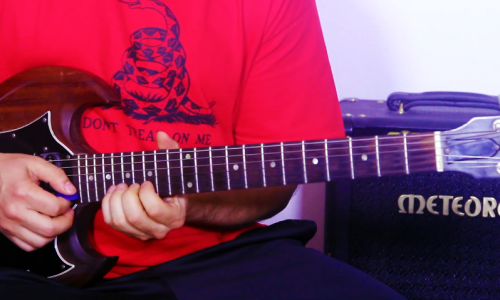
All Rights Reserved © 2011- 2024 GuitarControl.com